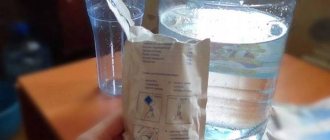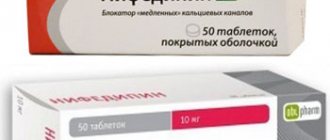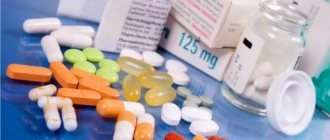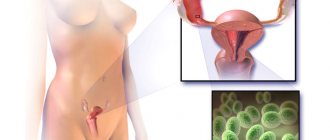Colonoscopy provides the proctologist with a rare opportunity to visually examine and evaluate the inner surface of the colon. The procedure is carried out using a special instrument - a colonoscope. A patient who has received a referral for such an examination for the first time often experiences fear and anxiety, and often refuses diagnosis altogether. To dispel unnecessary fears, below we will consider the features of the procedure, find out how to prepare for a colonoscopy and talk about the consequences.
The preliminary stage includes not only certain physical manipulations, but also a favorable emotional mood, the absence of fear and prejudice. Therefore, it would not be superfluous to dwell on some general aspects of the procedure.
Preparing for a colonoscopy: features, rules and popular drugs
Colonoscopy is a diagnostic method that allows you to assess the condition of the inner lining of the colon. It is classically performed using an endoscope - a device designed to visually examine the surface of an organ, perform a biopsy or treat detected lesions, the size of which may be even less than 1 mm.
In some cases, traditional endoscopy is replaced by irrigoscopy (diagnosis using X-rays) and virtual colonoscopy (reconstruction from CT and MRI results). All these methods give different results in accuracy, but require the same preparation, which consists in emptying the intestines of food debris.
What it is
Colonoscopy is a method of diagnostic examination of the intestines using a probe inserted into the anus.
Colonoscopy
The colonoscope is equipped with a small camera and a light.
Video endoscope colonoscope
The device also includes a tube that supplies air and miniature forceps that allow you to take a sample of mucous membrane for biopsy.
The camera transmits the image to the screen, and the specialist can assess the tissue structure and possible defects in an enlarged form.
Colonoscope with high definition images
Colonoscopy allows you to identify the following conditions and indicators in the intestines:
- inflammation of the mucous membrane;
- motor impairment;
- size of the intestinal lumen;
- the presence of scar changes;
- area of opened bleeding;
- the presence of tumors, cracks, hemorrhoids, ulcers, polyps.
What can be diagnosed with a colonoscopy?
Attention! It is advisable to undergo a colonoscopy at least once every 3 years, especially for older people, to timely identify possible signs of colon cancer.
According to WHO, from the age of 40, colonoscopy is recommended for all healthy people.
General rules
In order to correctly identify intestinal pathologies and avoid misdiagnosis, it is necessary to exclude the presence of foreign masses in the examined cavity. In addition, proper preparation makes the procedure easier and at the same time reduces the risk of unpleasant consequences for the patient. It is for this reason that attending physicians rarely prescribe emergency endoscopy. In most cases, colonoscopy is preceded by 3–4 days allocated for the preparation of the digestive tract, which is performed in 2 stages:
- slag-free diet;
- preparatory enema or cleansing with laxatives.
The first step is aimed at freeing the digestive tract from indigestible substances and stabilizing intestinal motility. The second is to get rid of the chyme remaining after the previous stage of preparation.
Each of these steps must be carried out in strict accordance with the recommendations of the attending physician..
Patient reviews
Based on feedback from people who have undergone colonoscopy, medications played a significant role in preparing for the study.
Larisa: “I took a few hours off from work in the afternoon for a colonoscopy, followed a diet, and I was staggering from hunger. I talked to the doctor about the medications. It is simply unrealistic to drink such a volume of liquid the day before. I don't have constipation, quite the opposite. In the evening I drank Duphalac and didn’t get off the toilet all night. But the procedure was successful.”
Galina: “My mother was scheduled for a colonoscopy. She is hypertensive. How to drink so much water? The doctor ordered me to strictly follow a slag-free diet for a week, not 3 days. In the evening and in the morning I gave her enemas. It worked out.”
Marina: “And I immediately realized that I couldn’t work. I took 3 days off. Fortrans can be endured if you drink and lie down, doing nothing.”
You should not try to choose the best laxative for yourself. In order not to disrupt the necessary procedure, you should carefully consider all preparation options. A combination of drugs and actions that are convenient in time and mode of operation will help to correctly complete the cleansing regimen.
Diet
Special nutrition before the procedure is aimed at minimizing the accumulation of gases, waste and chyme in the colon. It is for this reason that 3 days before a colonoscopy it is recommended to completely exclude the following foods from the diet:
- high in fiber - vegetables, herbs and seaweed;
- irritating intestines - spicy foods, fruits and berries, carbonated drinks and alcohol;
- disrupting the motility of the digestive tract - smoked meats, legumes, cereals, whole grain bread, seeds, nuts, milk.
In some cases, a longer diet is prescribed. So, for chronic constipation, it begins 5 days before the procedure, and for a colostomy - at least 7 days before the colonoscopy.
No less important are temporary pauses in the course of taking certain blood thinning and fluid-increasing drugs, bismuth and iron-containing drugs (the possibility of cancellation is previously discussed with the specialist who prescribed the medicine).
Slag-free diet
The basis of the preparatory diet is easily digestible foods that are digested in a short time and with the formation of the minimum possible amount of feces. These products include:
- made from premium white flour - baked goods, pasta;
- starchy, low in fiber - peeled potatoes, white rice;
- fermented milk - yoghurt, kefir, hard cheese;
- with quickly digestible protein - eggs, lean poultry and veal.
Permitted drinks include teas, fruit drinks and compotes, previously purified from fruit and berry fibers by straining.
The last meal is allowed no later than 12 hours before the colonoscopy. But in order to prevent unwanted effects, it is better to replace it with a glass of yogurt, kefir, broth or sweet tea with honey. Clear drinks can be consumed no later than 6 hours before the test. After this time, thirst is quenched by simply rinsing the mouth with warm water. .
Methods for colon cleansing before colonoscopy
The main task of the preparatory period three days before the study is to properly clean the large intestine of waste deposits, fecal accumulations, gases, possible blood clots and mucus.
Some patients have an extremely negative attitude towards taking any medications. Such people try to hide from the doctor the fact that they have started taking laxatives. Patients use other methods of cleansing the intestines:
- taking senna tea; the leaves of this plant have long been famous for their laxative effect;
- enema with a solution of herbs or plain water;
- suppositories with glycerin, which also have a laxative effect.
Indeed, all these remedies are good for cleansing the intestines at home. But there is one caveat. They are not able to replace tablets for colon cleansing before colonoscopy. The fact is that the procedure requires ridding the deepest areas of the intestine of fecal deposits. But special tea or an enema are not able to cope with this task.
A laxative for bowel cleansing before colonoscopy should have the following properties:
- soften stool in a short time;
- promote their removal from the body as quickly as possible;
- have minimal toxicity;
- have as few contraindications and side effects as possible.
If the patient tries to cheat and does not take the pills prescribed by the doctor, the result of the colonoscopy will be unsatisfactory. Feces will partially cover the mucous membrane, therefore, it will be difficult to draw a conclusion about its true condition. In addition, feces will prevent the device from passing into the intestines. To avoid any difficulties, you must follow all the rules prescribed by the doctor and take the drug and in the quantity that the doctor prescribes.
Enema before colonoscopy
This method of cleaning the intestines before conducting a diagnostic test is considered attractive because of its low cost. But questionable savings are accompanied by a number of disadvantages, including:
- difficulty of doing it yourself;
- risk of additional trauma and inflamed hemorrhoids or fissures in the rectum.
It is for these reasons that the enema, which was so popular until recently, is now practically not used in preparation for a colonoscopy. If for some reason this particular method was chosen, it should be carried out in 2 stages:
- in the evening, on the eve of diagnosis;
- in the morning, 2–3 hours before the procedure.
Both rinses are carried out with clean water heated to 35–38 degrees. A single “dose” for an adult is 1.5 liters. The number of washes is until emptying of a clear or lightly colored liquid occurs.
Since the inability to carry out a high-quality procedure without outside help causes a certain level of discomfort to patients, as well as due to the risk of additional injury to hemorrhoids or fissures, it is recommended to abandon enemas in favor of laxatives.
Microclystering
Preparation for examination with a colonoscope can be done through an enema. The enema cleansing procedure is carried out the evening before the scheduled colonoscopy and in the morning on the day of the examination. You can clean the small intestine with plain water or a non-concentrated solution of herbal decoctions. A single dose of liquid administered rectally should be at least two liters of water. As an alternative, a medicinal microenema is used.
Microlax
Combined laxative for rectal use in the absence of regular bowel movements and for preparation for examinations.
- composition: sodium citric acid, sorbitol, cleansing emulsifier – sodium lauryl sulfoacetate
- release form: produced in liquid form, in special micro vials made of polymer material, 5 ml each for one-time individual use;
- pharmacodynamics and pharmacokinetics: dilutes and removes intestinal contents. The time interval between enema and emptying ranges from 5 to 20 minutes;
- contraindications: rectal fissures, anal irritation;
- dosage: to eliminate constipation, use one microenema once a day. For cleaning purposes, apply twice (morning and evening), as with a regular enema;
Manufacturer, price: McNeil AB (Sweden), cost varies from 500 to 600 rubles
Cheaper lavage drugs, such as Bisacodyl, Senade, Fitolax, have a rather aggressive effect on the gastrointestinal tract, causing pain and spasms. In addition, forced cleansing may be of poor quality. Toxins and feces remain in the folds of the intestines, this becomes an obstacle to informative research.
All medications intended for lavage have a laxative effect. To avoid dehydration, medications should be used strictly according to instructions. Before choosing a medication, special attention should be paid to existing contraindications and side effects, and also consult a doctor.
Osmotic laxatives
The only significant drawback of this method of colon cleansing is the need to take 3-4 liters of water in a short period of time. But the benefits are much greater. These include:
- possibility of independent training;
- ease of use of drugs;
- gentle effect on the digestive tract;
- high-quality flushing of food debris from the intestines.
General rules for the use of osmotic laxatives boil down to strict adherence to the recommendations of the attending physician and the dosages specified in the instructions. Typically, taking the drug begins 18-15 hours before the colonoscopy. If the diagnosis is scheduled for the first half of the day, then the drug is taken in one stage - in the evening before the examination. When endoscopy is scheduled for the afternoon, 50% of the drug is used in the evening, and the rest in the morning.
The most common side effect when taking osmotic laxatives is nausea, accompanied by weakness and slight dizziness. These symptoms are the result of dehydration, indicating the need for a one-time increase in the intervals between taking portions of the drug solution from the recommended 15–20 minutes to 40–45 minutes. After a pause, you should continue the process of cleansing the intestines.
Often recommended drugs for bowel cleansing before colonoscopy are:
- Fortrans;
- Endofalk;
- Fleet;
- Moviprep;
- Lavacol.
It should be borne in mind that the specialist prescribing the drug does this based on the data of the preliminary examination and taking into account the individual characteristics of the patient. Therefore, it is recommended to purchase exactly the drug specified in the prescription. If it could not be found in pharmacies, analogues are selected only after preliminary consultation with the attending physician.
The most common mistake when purchasing osmotic agents is purchasing cheap formulations. Such dubious savings are associated with the risk of developing a large number of side effects due to the too harsh effect of the drugs on the body .
Fortrans
The action of an osmotic laxative is based on the ability of macrogol to bind water molecules, preventing their absorption by the walls of the digestive tract. Due to this, the intestinal contents increase, which stimulates the rapid elimination of digestive products naturally. The effect is enhanced by sodium picosulfate, which acts on the colon, activating peristalsis.
Excipients:
- sodium bicarbonate - counteracts heartburn and stomach pain;
- sodium chloride - restores water-salt balance;
- potassium chloride - compensates for potassium leaching, reducing the risk of heart failure.
Release form: powder for the preparation of oral solutions.
List of analogues: Endofalk, Diagnol, Moviprep, Diagnostic-Zdorovye, Kasenlax, Forlax, Tranzipeg and Legkolax.
Endofalk
An osmotic agent based on macrogol, a strong laxative that causes moderate diarrhea and promotes rapid cleansing of the large intestine. Its complementary salts (potassium and sodium chlorides, sodium bicarbonate) restore the water-salt balance, prevent the development of heart failure and reduce the risk of discomfort in the stomach.
Excipients: sodium saccharin, colloidal silicon dioxide, flavorings (orange, passion fruit).
Release form: powder for the preparation of oral solutions.
Analogues: Diagnostic-Health.
Fleet Phospho-soda
The main active ingredients (sodium dihydrogen phosphate, sodium hydrogen phosphate dodecahydrate) are aimed at retaining water in the intestinal lumen. Due to this, there is a softening and increase in the volume of feces along with mechanical stimulation of peristalsis, which contributes to the accelerated excretion of intestinal contents naturally. The effect is enhanced by sodium benzoate.
Excipients: water, glycerol, sodium saccharinate, flavorings (lemon, ginger).
Release form: solution for oral administration.
Analogues: no.
Moviprep
An osmotic laxative based on macrogol, which causes moderate diarrhea and promotes the rapid release of intestinal contents. To prevent the development of side effects, polyethylene glycol is supplemented with sodium sulfate, sodium and potassium chlorides - salts that prevent disturbances in the water-salt balance.
Excipients: ascorbic acid, sodium ascorbate, aspartame, acesulfame potassium, flavor (lemon).
Release form: powder for the preparation of oral solutions, packaged in two types of sachets. Package A - main active ingredients. Package B is a flavoring additive.
Analogues: no.
Lavacol
An osmotic agent, the main active ingredient of which is polyethylene glycol, which binds water molecules and prevents their absorption by the intestinal walls. Due to this, natural stimulation of peristalsis and rapid evacuation of the contents of the digestive tract occurs naturally. To prevent disturbances in the water-salt balance, the drug contains sodium sulfate and bicarbonate, as well as sodium and potassium chloride.
Release form: powder for the preparation of oral solutions.
Analogues: Tranzipeg, Osmogel and Fortrans.
"Flit" for bowel cleansing before colonoscopy
“Fleet” is a laxative that promotes water retention in the intestines, which leads to liquefaction and softening of stool and easier bowel movements. It has a purely local effect; the drug’s metabolites do not enter the bloodstream, as is the case with most newer laxative drugs. Cleansing the intestines before colonoscopy with the help of the drug "Flit" is possible, however, doctors prescribe it relatively rarely.
"Flit" has a number of contraindications for use; it cannot be used if you have the following diseases:
- pain in the abdominal area of any nature;
- in case of impaired renal function;
- ascites and cirrhotic disease are also contraindications;
- suspicion of intestinal obstruction;
- any pathological process accompanied by vomiting;
- acute infectious diseases of the gastrointestinal tract.
There are relatively few reviews about colon cleansing with Fleet before colonoscopy. Since it is not the first choice drug for this procedure. However, patients note that no side effects were noticed when taking it. Flit is well tolerated and causes bowel movements approximately five hours after administration.
Useful notes
Oral medications for colon cleansing are sometimes supplemented or replaced with medicated enemas. In such a situation, it is best to undergo pre-diagnostic preparation of the body in a hospital setting - this way the staff of the medical institution will be able to monitor the patient’s condition and take timely measures in case of side effects.
When searching for analogues of osmotic laxatives, you should focus not only on the names of the drugs, but also on their composition. Even if the main active ingredients are the same components, their ratio can play an important role. Moreover, some drugs contain different forms of the same ingredient. For example, macrogol (also known as polyethylene glycol) can have different molecular weights, which determines the intensity of its effect on the intestinal mucosa.
Some osmotic laxatives are supplied unflavored. Reviews from patients who have used such products indicate that the unpleasantly cloying taste can be softened by adding freshly squeezed lemon juice (100 g per 900 g of oral solution).
And finally, after undergoing a colonoscopy, you should adhere to the rules for breaking short-term fasting: non-acidic juices and sweet non-carbonated drinks precede the foods allowed during the diet. A smooth transition to the usual diet should begin no earlier than the third day after diagnosis. Violation of this principle will negatively affect the duration of restoration of normal functioning of the digestive tract.
Why is an intestinal colonoscopy necessary?
The patient is indicated for a colonoscopy for chronic abdominal pain, bleeding from the anus, chronic constipation, diarrhea and other intestinal problems.
You can also have a colonoscopy to check for bowel cancer. If the patient is over 50 years old and has no history of colon cancer in his family, the doctor may recommend that he undergo an abdominal examination with a colonoscope every 7-10 years.
If the patient is prone to the formation of polyps on the walls of the large intestine, colonoscopy should be performed at certain intervals in order to find and remove polyps that have arisen during the examination of the walls. This manipulation is performed to reduce the risk of rectal cancer.
Instructions for use of Forlax, dosage
The drug in powder form should be diluted in cool boiled water before use. The pediatric dose (4 g) should be diluted in 50 ml of water, and the adult dose (10 g) should be diluted in 250 ml of water. It is recommended to take the drug during meals or before meals.
The dosage of Forlax for constipation in adults is 1-2 sachets once a day. It is better to take the product in the morning. The duration of the course of treatment is determined by the attending physician.
The maximum daily dose for adults is 4 sachets.
If the patient has temporary changes in stool associated with operations or stress, as well as in the process of preparing for therapeutic and diagnostic measures on the large intestine, the use of the drug in a short course is allowed.
Forlax dosages for children (4g sachet):
- children 6-12 months are prescribed 1 sachet per day;
- children 1-4 years old – 1-2 sachets per day;
- children 4-8 years old – 2-4 sachets per day.
According to the instructions for use, if a doctor prescribes a daily dose of more than 1 sachet per day, it should be divided into two doses. The duration of the course of treatment should not exceed 3 months.
The effect of Forlax is noted only after 1-2 days from the moment of administration. During treatment, it is recommended to maintain sufficient physical activity, drink more water and eat foods rich in plant fiber.
Side effects
The most common negative effects from taking this laxative include:
- dyspepsia in its various manifestations (nausea, diarrhea, vomiting, abdominal pain, pain in the anus and rectum, etc.);
- allergic reactions;
- dehydration and salt imbalance;
- in some cases there is a headache.
To minimize the negative effects of laxatives on the body, you need to drink plenty of fluids.
Fortrans instructions for use before colonoscopy
Fortrans is a box containing bags of powder and instructions for use.
Each bag is designed for 20 kilograms of weight. That is, if you weigh 60 kilograms, then you need to take three of these sachets of colon cleansing powder before a colonoscopy in order to prepare for a colonoscopy with Fortrans. The dosage regimen is as follows: one packet is dissolved in one liter of water. The resulting solution, taking into account your weight, must be drunk within 4 hours. It turns out that you need a glass of fortrans powder diluted in water for every fifteen minutes before laparoscopy. Reviews for this drug are mostly positive. The first urge to have a bowel movement will occur in about an hour.
Cleansing the intestines with Fortrans before a colonoscopy will last until clear water flows out instead of feces. A procedure such as preparation for a colonoscopy with Fortrans should be treated calmly. Graduality in cleansing the intestines is very important. The stool should be well softened so as not to cause pain upon exit.
Do not be afraid of preparing for intestinal colonoscopy with Fortrans. This drug quite delicately prepares the intestines for colonoscopy. But there are still contraindications
Therefore, it is very important to properly prepare for a colonoscopy.
There are a couple more products that can easily replace Fortrans - Lavacol, Duphalac, Fleet Phospho-soda.
Table of similar medications
Name Release form Active components Indications Contraindications At what age can it be taken Can it be used during pregnancy Price Fortrans Macrogol powder Preparation for endoscopic diagnosis of the intestine severe heart disease; gastrointestinal obstruction; malignant neoplasms of the intestine; inflammatory processes in the lower gastrointestinal tract.
From 15 years old With caution From 531 rub. Forlax macrogol constipation; bowel cleansing before surgery.
Crohn's disease; perforation of the colon; nonspecific ulcerative colitis; intestinal obstruction; abdominal cramps of unknown origin.
From 6 months With caution From 255 rub. Exportal lactitol monohydrate severe liver diseases; disturbances of intestinal microflora; preparation for x-ray examination, colonoscopy, and surgery.
gastrointestinal obstruction; severe inflammatory bowel diseases; gastrointestinal bleeding.
From 1 year With caution From 250 rub.
Description of the procedure
Colonoscopy refers to endoscopic diagnostic methods. A probe is inserted into the patient's large intestine and the mucous membrane is examined using a special camera. This makes it possible to identify tumors, inflammations and polyps at an early stage.
The procedure may be painful. Unpleasant sensations usually occur when the probe passes through the natural bends of the intestine. Therefore, colonoscopy is performed in most cases under local anesthesia. If the pain threshold is low, general anesthesia is used.
In order for the doctor to examine the organ, the intestines must be cleared of feces. It is quite difficult to achieve the necessary cleansing of the gastrointestinal tract using an enema. Therefore, before the procedure, the patient is usually prescribed strong laxatives. It is also necessary to adhere to a diet before intestinal colonoscopy. This will help free the gastrointestinal tract from toxins.
LIST OF ALLOWED AND PROHIBITED PRODUCTS
Nutritionists' recommendations for cleansing the intestines from blockages are aimed at freeing the entire body from accumulated toxins and toxic substances during prolonged constipation. A slag-free diet helps, after holiday overeating, to eliminate the consequences for the body and restore proper protein and fat metabolism.
Before a colonoscopy, it is recommended to eat the following foods:
- from lean meat, preferably poultry, boiled, in steam cutlets;
- vegetable soups with the addition of carrots and potatoes, rich fish broth;
- soft-boiled chicken eggs or in the form of a steam omelet;
- cereal products (rice porridge, buckwheat with water);
- low-fat cottage cheese and kefir, sugar-free yogurt;
- dried wheat bread;
- dry biscuits (biscuits, crackers);
- vegetable oil;
- mild cheese.
If you have a strong desire for sweets, you can eat a teaspoon of honey. The total volume of drinks (at least 1.5 liters) includes drinks without sugar: green tea, dried fruit compote, jelly, still mineral water.
The list of prohibited products includes:
- whole milk;
- all fresh vegetables, fruits;
- legumes;
- nuts;
- from cereals pearl barley and millet;
- black bread;
- sweets and confectionery;
- carbonated drinks.
Half of the patients suffer from severe dietary restrictions and complain of headaches and nausea. According to nutritionists, these are signs of the beginning of cleansing. To make it easier to transfer the regime, it is proposed to lengthen the preparation time from three days to a week.
Preparing for a colonoscopy using osmotic laxatives
Although an enema is certainly effective, the process of preparing and administering one yourself can be difficult and unpleasant for the patient. Modern drugs come to the rescue, in particular, osmotic laxatives containing macrogol. The effectiveness of intestinal cleansing with drugs containing macrogol depends only on the volume of the solution drunk. It is necessary to consume at least three to four liters; Fortunately, since the days of magnesium sulfate, medicine has stepped forward and their taste is not so disgusting. As a last resort, you can always use a sweetener or flavoring agent like lemon or ginger juice.
The advantage of macrogol-based laxatives is that they do not cause dehydration of the body, and even vice versa - the osmotically active substances they contain retain water entering the intestines, thereby facilitating rinsing and cleansing of the intestines at the enema level. Osmotic laxatives are especially good for cleaning the descending colon and sigmoid colon, where enema water may not reach.
Trade names of drugs containing macrogol are Forlax, Lavacol, Fortrans. As a rule, the dose of the drug is calculated based on the patient’s weight - one sachet of the drug dissolved in 1 liter of water for every 15-20 kg of the patient’s body weight. Since it is difficult to immediately drink such a volume of water, the patient is recommended to drink a glass of the solution every 20 minutes.
If Fortrans is suitable for patients without complications, then Forlax is designed specifically for those who, for health reasons, are not able to drink so much fluid (for example, for people suffering from cardiovascular diseases or gastric ulcers). The drug is dissolved in a glass of water and taken either two sachets once a day (in the morning), or two sachets in the morning and evening for three days before the day of the examination. When using Forlax, an enema cannot be avoided - it is advisable to give yourself one small enema a couple of hours before the procedure.
Before colonoscopy: two hours
You can't eat or drink (not even water). This prohibition arose for a reason - due to the presence of water in the stomach, colonoscopy can cause vomiting, which a patient under general anesthesia can choke on. Some medical institutions require a longer period of abstinence from water (up to 8 hours), so it is recommended to clarify this issue in advance.
Special underwear.
Since the device is inserted through the anus, the patient must remove all clothing up to the waist. For many, this nuance brings a lot of discomfort, they feel even more uncomfortable.
Special underwear will help a person feel as comfortable as possible. It is made of hypoallergenic material and also has a hole for a probe. Therefore, a person should take care of his comfort in advance and purchase such panties at the pharmacy.
ENEMA
Enemas are used when there is no time for long-term preparation or there are contraindications to medications. Regardless of the place where the patient is (in the clinic or at home), the following algorithm of actions must be followed:
- Pour boiling water over the enema mug in advance and boil the tips;
- treat the perineum with soap;
- fill the container with boiled water at room temperature (1.5–2 l);
- Apply a small amount of Vaseline to the tip and entrance of the anus;
- place Esmarch's mug at a height of at least 1.5 m;
- carefully insert the tip into the anus;
- open the valve and relax your abdominal muscles, allowing water to enter;
- at the end, turn off the valve, lie on your back or walk for 5 minutes, massaging your stomach;
- completely relax the sphincter and try to empty your bowels on the toilet.
Important! The procedure should be painless. Do not introduce water under pressure.
There is no guarantee that after the first enema the cleansing will be complete. It is recommended to repeat the procedure and be guided by the color of the water released from the rectum. When cleaned well, the liquid appears slightly yellowish.
Usually the first enema is given in the evening, the second in the morning.
Expert advice
In addition to the information contained in the instructions, it is important to listen to the advice of doctors who know how best to use this drug. So, you need to eat a couple of hours before your appointment.
True, you shouldn't overeat. Better yet, let it be a light snack.
You should not eat or drink Fortrans. While taking it, you are allowed to drink only clean water. If after the first sips nausea or vomiting occurs, then you should not immediately abandon the drug. After a few glasses, the body gets used to it and stops reacting like that.
An endoscopic diagnostic method called colonoscopy is the only one that allows you to examine the entire colon, visually determine the presence of ulcers, tumors, polyps, perform a biopsy, and remove the affected areas.
An important pre-stage of the examination is preparation for it; the accuracy of the final results depends on the degree of intestinal cleansing. Many experts recommend that patients refuse enemas for cleansing and give preference to medications, for example, Fortrans.











